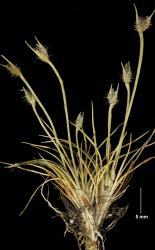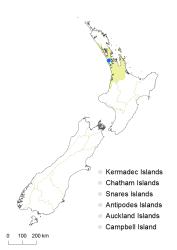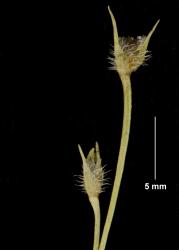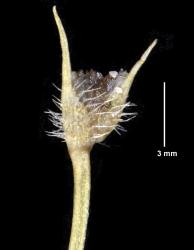- Taxon
- Gallery
- = Devauxia billardieri R.Br., Prodr. Fl. Nov. Holland. 252 (1810) pro parte
- = Centrolepis cuspidigera Rudge, Trans. Linn. Soc. London 10: 283 (1811) nom. illeg.
- = Devauxia longifolia Gaudich., Voy. Uranie, Bot. 419 (1829)
- ≡ Centrolepis longifolia (Gaudich.) Kunth, Enum. Pl. 3, 489 (1841)
Perennial cushion, 15–70 mm high. Stem internodes condensed and not discernible. Leaves spiral, appearing radical, spreading. Leaf-sheath 2–4 mm long, hyaline, with multicellular hispid hairs. Leaf-sheath auricles absent; aligulate. Leaf-lamina 8–20 × 0.3–0.5 mm, filiform, with an acicular apex, terete, a few multicellular hairs below, glabrous above. Uppermost leaf reduced to a membranous cataphyll. Flowering stems 8–65 mm long, glabrous. Inflorescence an ovoid spike, 3.5–5 × 2–3.5 mm. Outer primary floral bract 3.5–5 mm long, ovate and contracting to a spreading, glabrous foliar point; covered with multicellular hispid hairs, hyaline margins ciliate. Inner floral bract, 2.5–4 mm long, ovate and contracting to a spreading, glabrous foliar point, covered with multicellular hispid hairs; hyaline margins ciliate. Primary bracts separated by an internode 0.5–1 mm long. Secondary hyaline scales present, 2/reproductive unit. Reproductive units/spike 7–9, all bisexual. Androecium 1 stamen; filament capillary, 2–4 mm long; anthers ellipsoid, 0.48–0.8 mm long. Gynoecium (2)–3–4 connate, superposed carpels. Styles stigmatic with simple papillae, crimson. Seeds 0.5–0.6 × 0.23–0.3 mm, oblong-ovoid, yellow-brown, striated.
Distinguished from all other centrolepids in New Zealand, except for C. strigosa, by the presence of hairs on the primary floral bracts. Distinguished from C. strigosa by a glabrous flowering stem and a more or less glabrous leaf-lamina with just a few hairs on the lower lamina. Also, C. fascicularis has fewer RUs/spike compared with C. strigosa.
North Island: North Auckland, Waitakere Ranges, Swanson Stream Catchment, Watercare Filter Station "Floc Pond".
Indigenous to Australia, occurring in six states: South Australia, Victoria, Tasmania, New South Wales, Queensland, and Western Australia (possibly introduced) (Cooke 1992).
Heathland, bogs; infertile soils
Flowering: Nov.-Feb.
Known from one locality growing in open Leptospermum scoparium heathland on the edge of an artificial flocculation pond at a water treatment facility.







